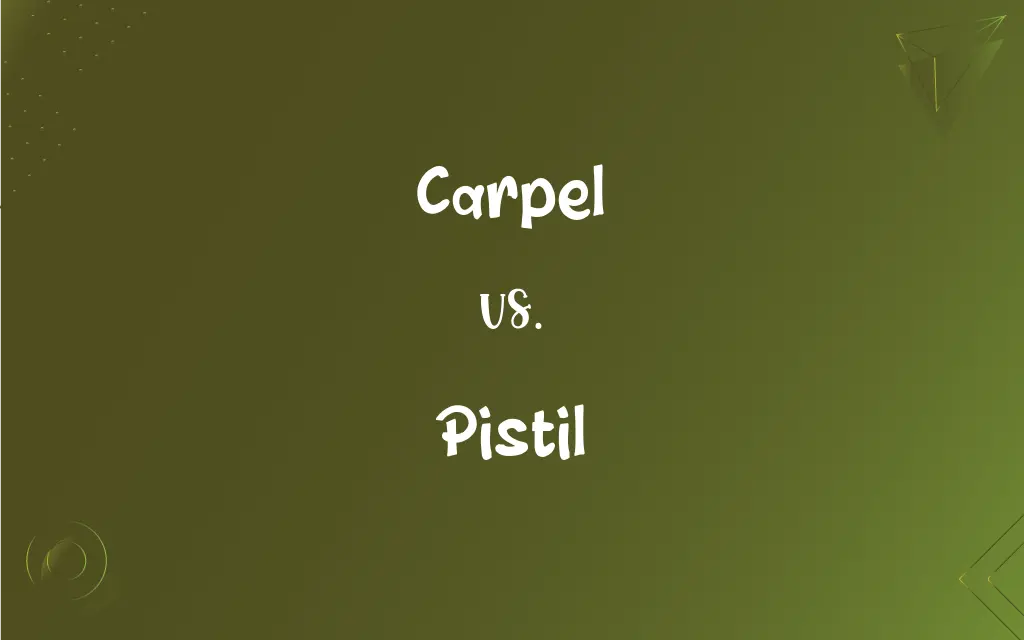Carpel vs. Pistil: What's the Difference?
Edited by Aimie Carlson || By Harlon Moss || Published on February 8, 2024
A carpel is the individual ovule-bearing unit of a flower, while the pistil may consist of one carpel or multiple fused carpels.

Key Differences
A carpel is the basic unit of the female reproductive part of a flower, consisting of an ovary, style, and stigma. It is the structure that encloses and supports the ovules. In contrast, a pistil may be formed from one single carpel or multiple carpels that are fused together. The pistil is the entire female reproductive structure that can be a combination of several carpels.
The function of the carpel is to produce and shelter the ovules and later, if fertilization occurs, to develop into fruit. The pistil, encompassing all carpels of a flower, serves as the broader structure for sexual reproduction in plants, playing a crucial role in the pollination process. This distinction highlights the specific role of carpels versus the collective function of the pistil.
In simple terms, the carpel can be seen as the individual building block of the female part of the flower. Each carpel contains its own ovary, style, and stigma. The pistil, however, might be a single carpel or a complex of several carpels, representing the entirety of the female reproductive organ in a flower.
In botanical terminology, a flower with only one carpel is described as monocarpous, and its single carpel constitutes the entire pistil. Conversely, a flower with multiple carpels, whether fused together (syncarpous) or separate (apocarpous), forms a compound pistil. This shows how the carpel is a component part, whereas the pistil is the composite structure.
When identifying flower parts, each individual carpel can sometimes be difficult to distinguish in flowers with a compound pistil. The pistil, on the other hand, is usually more evident, being the prominent center structure of the flower, composed of all the carpels, whether they are distinct or fused.
ADVERTISEMENT
Comparison Chart
Definition
Individual ovule-bearing unit of a flower.
The entire female reproductive part of a flower.
Composition
Consists of an ovary, style, and stigma.
May be one carpel or multiple fused carpels.
Role in Flower
Produces ovules; develops into fruit.
Overall structure for sexual reproduction.
Types
Single in monocarpous flowers.
Single or compound in various flowers.
Visibility
Less distinct in compound structures.
Prominent center structure in the flower.
ADVERTISEMENT
Carpel and Pistil Definitions
Carpel
The individual female reproductive organ of a flower.
Each carpel in the flower contained its own ovary.
Pistil
The complete female reproductive structure in a flower.
The pistil is the central, often large part of the flower.
Carpel
A flower part that encloses ovules and develops into fruit.
The carpel's ovary will turn into a fruit after fertilization.
Pistil
The center part of a flower responsible for reproductive processes.
Bees frequently visited the flower's pistil for nectar.
Carpel
The structural unit of the female reproductive system in plants.
The botanist examined the carpel to determine the plant's species.
Pistil
The organ in flowers that encompasses the carpels.
The pistil's prominent position attracts pollinators.
Carpel
The ovule-producing part of a flower, including ovary, style, and stigma.
The carpel's style connects the stigma to the ovary.
Pistil
A flower part that may consist of one or more carpels.
This flower's pistil is composed of three fused carpels.
Carpel
A single unit that can be part of a larger pistil structure in flowers.
In this flower, several carpels are fused to form the pistil.
Pistil
The collective structure of ovary, style, and stigma in flowers.
The pistil of the lily was remarkably long and slender.
Carpel
One of the structural units of a pistil, representing a modified, ovule-bearing leaf.
Pistil
The female, ovule-bearing organ of a flower, including the stigma, style, and ovary.
Carpel
(botany) A constituent part of a flower pistil - the individual female reproductive organs in a flower. A carpel is composed of an ovary, a style, and a stigma, although some flowers have carpels without a distinct style. In origin, carpels are leaves (megasporophylls) that have evolved to enclose the ovules. A pistil may be composed of a single carpel or of several carpels fused together.
Pistil
(botany) A discrete organ in the center of a flower capable of receiving pollen and producing a fruit, it is divided into an ovary, style and stigma.
Some plant species have more than one pistil per flower.
Carpel
A simple pistil or single-celled ovary or seed vessel, or one of the parts of a compound pistil, ovary, or seed vessel. See Illust of Carpaphore.
Pistil
The seed-bearing organ of a flower. It consists of an ovary, containing the ovules or rudimentary seeds, and a stigma, which is commonly raised on an elongated portion called a style. When composed of one carpel a pistil is simple; when composed of several, it is compound. See Illust. of Flower, and Ovary.
Carpel
A simple pistil or one element of a compound pistil
Pistil
The female ovule-bearing part of a flower composed of ovary and style and stigma
FAQs
Can a pistil have multiple carpels?
Yes, a pistil can consist of multiple fused carpels.
What is a pistil?
A pistil is the complete female reproductive structure in a flower.
What are the parts of a carpel?
A carpel includes an ovary, style, and stigma.
What is the role of the pistil in a flower?
The pistil plays a central role in the flower's reproductive processes.
What is a monocarpous flower?
A monocarpous flower has a single carpel.
What is a carpel?
A carpel is the individual female reproductive unit of a flower.
How does a carpel relate to fruit formation?
The carpel's ovary develops into fruit after fertilization.
Is a single carpel the same as a pistil?
In some flowers, a single carpel can constitute the entire pistil.
How do carpels aid in plant reproduction?
Carpels produce ovules and facilitate fertilization and fruit development.
Can the pistil be easily seen in a flower?
Yes, the pistil is usually a prominent structure in the flower.
How do carpels and pistils differ in function?
Carpels are individual reproductive units, while pistils are the collective structure.
What is an apocarpous flower?
An apocarpous flower has multiple, separate carpels.
Can carpels be fused together?
Yes, carpels can be fused together to form a compound pistil.
Do all flowers have carpels?
Yes, all flowers have carpels as part of their female reproductive organs.
What is the difference between a simple and compound pistil?
A simple pistil has one carpel, while a compound pistil has multiple.
What happens to the carpel after pollination?
After pollination, the carpel can develop into fruit and seeds.
How do carpels contribute to plant diversity?
Carpels vary in structure and number, contributing to the diversity of fruit and flower forms.
Can a flower have more than one pistil?
Yes, some flowers can have more than one pistil.
Is the stigma part of the carpel?
Yes, the stigma is the uppermost part of the carpel.
Are pistils always visible in flowers?
Generally, yes, pistils are visible as the central part of most flowers.
About Author
Written by
Harlon MossHarlon is a seasoned quality moderator and accomplished content writer for Difference Wiki. An alumnus of the prestigious University of California, he earned his degree in Computer Science. Leveraging his academic background, Harlon brings a meticulous and informed perspective to his work, ensuring content accuracy and excellence.
Edited by
Aimie CarlsonAimie Carlson, holding a master's degree in English literature, is a fervent English language enthusiast. She lends her writing talents to Difference Wiki, a prominent website that specializes in comparisons, offering readers insightful analyses that both captivate and inform.







































































